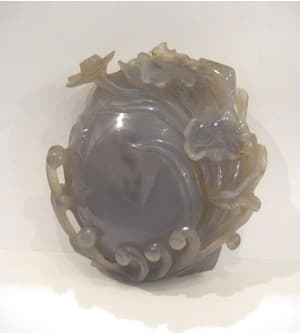Chalcedony Carving with Trapped Water, 15th Century CE - 16th Century CE
Chalcedony
4.5 x 4.9
TF.027 (LSO)
This beautifully-finished piece is a M’ing rendition of a floral bouquet, rendered in chalcedony, containing a quantity of water that adds to the depth of the stone’s natural colour. The...
This beautifully-finished piece is a M’ing rendition of a floral bouquet, rendered in chalcedony, containing a quantity of water that adds to the depth of the stone’s natural colour. The object is essentially spherical, with a drapery of plants (perhaps intended to be lilies or lotuses, although the species in question is unlikely to be relevant) and tendrils of leaves wrapped sinuously around it. The detailing is exquisite, the carving extremely fine. The added lustre of the water makes the piece effervesce beyond the stone’s natural capacity.
The delicacy of this object is at odds with the period that produced it. Established in 1368, the M’ing dynasty was founded by Hong Wu, one of only three peasants ever to rise to imperial pre-eminence. His attitudes towards rule reflected his own past, with considerable emphasis on agricultural production, an aversion to trade, a massive expansion of military power and spending a fortune on defences (notably the Great Wall). This philosophy, while partly reflexive, was based loosely upon Confucianism, with which China had had a love-hate relationship for much of the preceding millennium. Despite his prejudices, the inevitable effect of Hong Wu’s policies was stability, and with it the rise and rise of the middle classes. While in many respects a martially vigorous and ascetic time, the enormous wealth generated by agricultural surpluses led to an unexpected flowering of arts under the patronage of what was essentially the nouveau riche, who liked to surround themselves with delicate artworks including lacquer work, paintings, prestige ceramics, sculptures and bijouterie such as this.
This piece is also symbolic, as it dates to the last period of indigenous (Han) Chinese rule before the invasion of M’ing China by the Manchu-led Q’ing Dynasty in 1644. This would have belonged to a (probably female) member of the social elite at the time, and was a prized and expensive item.
This is a beautiful piece of Chinese mobiliary art.
The delicacy of this object is at odds with the period that produced it. Established in 1368, the M’ing dynasty was founded by Hong Wu, one of only three peasants ever to rise to imperial pre-eminence. His attitudes towards rule reflected his own past, with considerable emphasis on agricultural production, an aversion to trade, a massive expansion of military power and spending a fortune on defences (notably the Great Wall). This philosophy, while partly reflexive, was based loosely upon Confucianism, with which China had had a love-hate relationship for much of the preceding millennium. Despite his prejudices, the inevitable effect of Hong Wu’s policies was stability, and with it the rise and rise of the middle classes. While in many respects a martially vigorous and ascetic time, the enormous wealth generated by agricultural surpluses led to an unexpected flowering of arts under the patronage of what was essentially the nouveau riche, who liked to surround themselves with delicate artworks including lacquer work, paintings, prestige ceramics, sculptures and bijouterie such as this.
This piece is also symbolic, as it dates to the last period of indigenous (Han) Chinese rule before the invasion of M’ing China by the Manchu-led Q’ing Dynasty in 1644. This would have belonged to a (probably female) member of the social elite at the time, and was a prized and expensive item.
This is a beautiful piece of Chinese mobiliary art.
